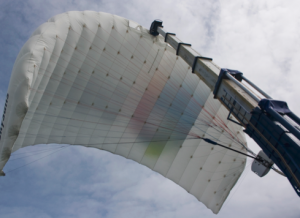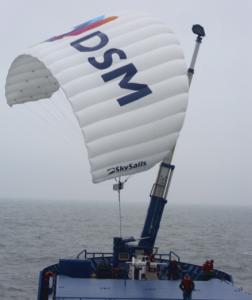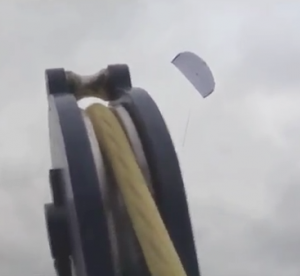In the distant past, global trade was powered by wind. Then came the arrival of steam power, then diesel engines, and finally cargo sailing ships were relegated to the history books and swank dinner cruises. Or maybe not. Along with advances in materials science - providing the world's strongest rope - and new kinds of wind-propulsion technology (kites), we may be about to see a second golden age of wind-assisted shipping. Watch the video in the upper right window. With around 90% of all global trade today transported by sea, the shipping industry is one of the world's biggest sources of greenhouse gas, a staggering 843 million tons of CO2 emissions annually. This is greater than the total CO2 production of the United Kingdom, and just behind that of Germany. To address this urgent problem, as well as to find a solution to its dependence on oil, the industry had begun looking in earnest for alternative, more sustainable forms of energy.

Modern wind power
The solution of sails wasn't obvious. Although wind is free, it's intermittent, and surface wind speeds aren't strong enough to propel a large cargo ship. While they don't create carbon dioxide, traditional sails have serious drawbacks: they're

expensive and inefficient. But knowing that wind speed increases with altitude, Hamburg-based SkySails developed a high-flying kite propulsion system instead. Lofting 100-420 meters above cargo ships, SkySails exploit high altitude wind speeds to generate between five and 25 times the energy of conventional sails. Tethered to the deck, SkySails don't require a traditional mast , which means they take up much less deck space, and they can be easily stowed.
The world's strongest fiber
The SkySail remained an untested concept for a long time because it required a tow rope that had never been developed - on that was lightweight and incredibly strong. Steel ropes were far too heavy, and conventional ropes were simply too weak to withstand the extreme pressures. The concept waited for technology to catch up.

Eventually, SkySails was able to adapt a special fiber developed by DSM, a global materials company, that was 15 times stronger than steel. Successful sea-trials came next. According to the press release, the environmental and financial benefits are compelling: Their kites can reduce fuel consumption and emissions by up to 35%, and if applied across the shipping industry, would reduce CO2 emissions by around 150 million tons a year - roughly equivalent to the annual emissions of Belgium or the Netherlands. The product has been so successful that DSM Venturing, a corporate investment unit of Royal DSM N.V., recently announced that it had invested in Germany-based SkySails GmbH & Co. KG. They will be sailing off into the low-carbon sunset together.




Comments
I was just talking with someone about this, really great idea. This will also become a lot more cost effective when the new bunker fuel rules are in place - ship fuel is going to get a lot more expensive if the rules stay.
Maresk (currently in the middle of a demo cruise) is experimenting with biofuels, and as prices drop over the next decade, that'll also be a positive change. There are also plans for LNG shipping too. Did you notice that a Japanese ship is running with a whole deck of PVs powering on-board leds?
I hadn't noticed. But makes sense, one of those little things that can help shave some energy consumption.